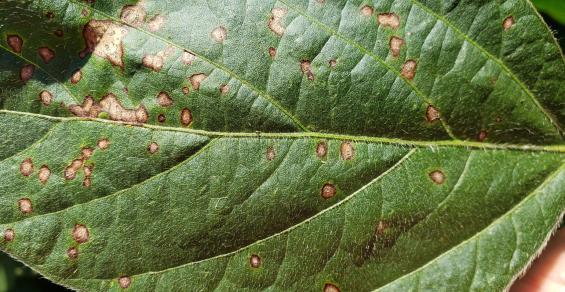Frogeye leaf spot is not uncommon on soybean plants, but Tamra Jackson-Ziems says one of her graduate students made a discovery that may be of concern.
“We’re seeing resistance to one of the fungicide groups, Group 11 QoI [quinone outside inhibitor, formerly Strobilurin], in many other states,” says Jackson-Ziems, a professor of plant pathology at the University of Nebraska-Lincoln.
Asha Mane, one of Jackson-Ziems’ graduate students, “has confirmed fungicide resistance in our frogeye leaf spot.” Jackson-Ziems presented this information during the January Crop Production Clinics hosted by Nebraska Extension.
Sampling was conducted in 48 counties in eastern Nebraska, and resistance was found in all of the 375 samples pulled from 128 different fields in that geographic area, representing the majority of the soybean-growing acres of Nebraska. “So, I think you can safely say that if you’re looking at frogeye leaf spot out in the field, it is likely resistant to the Group 11 fungicides,” Jackson-Ziems says.
Identifying the small, tan, oval lesions with dark borders on the upper leaves may not be difficult, but what can soybean farmers do to battle this fungus that’s shown to affect yields, especially in light of this finding of resistance to the Group 11 fungicides?
Jackson-Ziems says updated recommendations reflect the inefficacy of the Group 11 products, and now call for mixed products with two or three different classes or modes of action.
She also suggests seeking soybean varieties resistant to frogeye leaf spot, although those options aren’t as plentiful for farmers to the south. “Also, crop rotation can help us because this fungus overwinters in the crop residue and will break down over time,” she adds.
Phytophthora root and stem rot
Phytophthora root and stem rot has become more prevalent over the past few years. Even though it has been known primarily as a seedling disease, “it can kill plants all the way through the season until the end.”
Research in Nebraska and Iowa has found that common Rps resistance genes in soybean varieties — Rps 1c and Rps 1k — “are not effective against 70% of the Phytophthora strains that are in Nebraska and Iowa,” Jackson-Ziems says. “So that might explain why we are seeing so much more of the Phytophthora than we might have seen in the past.”
SPREAD IN SOYBEAN COUNTRY: The counties shaded orange indicate those where resistance to Group 11 fungicides appeared. These counties also represent the main soybean-production counties in the state.
Jackson-Ziems says this same research proved that Rps 3a resistance is most effective, and suggests farmers find varieties with that gene. If locating a soybean variety with resistance proves difficult, she suggests seed treatment fungicides, but warns that older chemistries such as mefenoxam and metalaxyl would need to be used at high rates for Phytophthora root and stem rot, and some newer chemistries also appear to be effective.
Although not as effective as finding a good Rps gene, she says it may be possible to manage Phytophthora by getting partial resistance, “or what we call field tolerance,” which can be effective but is not race specific.
Soybean cyst nematode
Jackson-Ziems recommends that farmers use the soybean cyst nematode testing program made available at no cost through the UNL Plant and Pest Diagnostic Clinic through support from the Nebraska Soybean Board.
If soybean cyst nematode exists in fields, Jackson-Ziems suggests rotating soybean varieties with different resistance sources. PI 88788 is popular with Nebraska growers in more than 95% of resistance varieties, but 47% of SCN can infect those beans. She adds that resistant varieties derived from Peking show promise in that about 30% of the SCN in the state can infect those, as does PI 89772 that is new to Nebraska growers.
“Those [PI 89772] varieties are from the maturity group 2.3, so they might not work well for everybody,” she says. “But even then, although we haven’t used it, we still have populations [25%] of this nematode that can reproduce on it.”
Rotating among the two or three varieties with resistance genes is recommended to slow or reduce SCN adaptation to resistant varieties.
White mold
Last year was a bad year for white mold, which may seem ironic during a drought since the fungus infecting the flowers thrives in moist conditions.
“Senescing flowers are where the infection points occur,” Jackson-Ziems says. “The problem is that when we irrigate frequently like we did during the very dry year we had this past year, we support more infection and higher humidity inside the soybean canopy where infection takes place.”
Narrow row spacing and indeterminate soybean varieties that bloom for an extended period of time also present a prime breeding ground for white mold, as those varieties develop flowers at almost every node at some point, “and especially when those flowers are developing in a canopy that closes very early, keeping it damp longer and favoring infection by the fungus.”
Knowing that, Jackson-Ziems recommends not irrigating during flowering if possible, but if irrigation is needed, do so less frequently and water deeper to reduce canopy moisture, and ultimately white mold.
Technology can also aid farmers in optimal timing of fungicide applications with the Sporecaster app from the University of Wisconsin, available in Apple and Android stores. Jackson-Ziems cautions that the app doesn’t know whether white mold in present in fields, or whether irrigation has been used. The app uses a combination of user inputs and GPS-referenced weather information to provide a risk of white mold to help farmers make spraying decisions.
Timing is everything when applying fungicides to tackle white mold, being most effective at the R1 and R3 stages. “We can’t wait until we see evidence of white mold in the field to treat with fungicides,” she says.
Learn more by contacting Jackson-Ziems at tjackson3@unl.edu.
Resistance calls for a different approach in controlling common and emerging soybean diseases.




